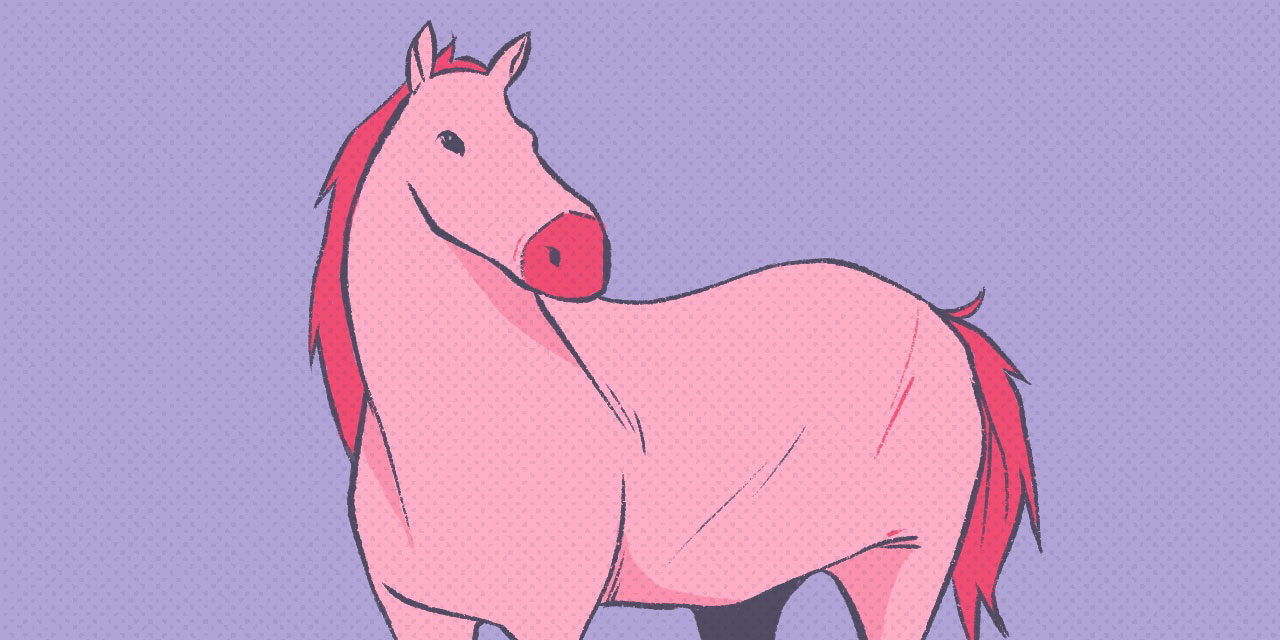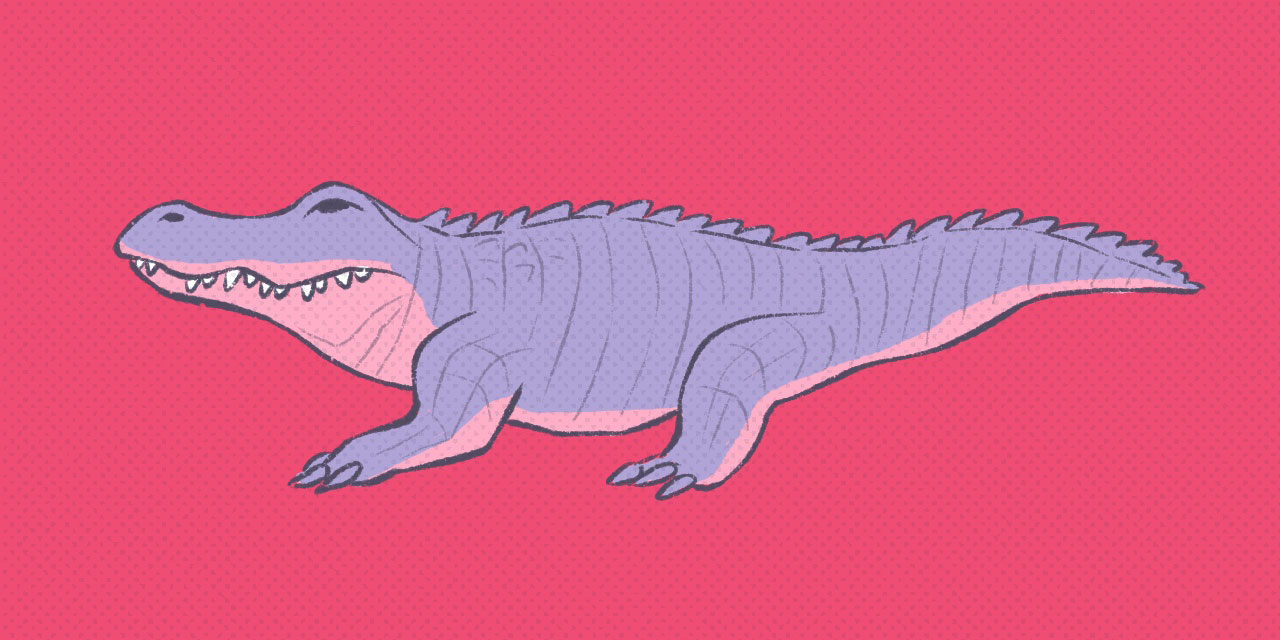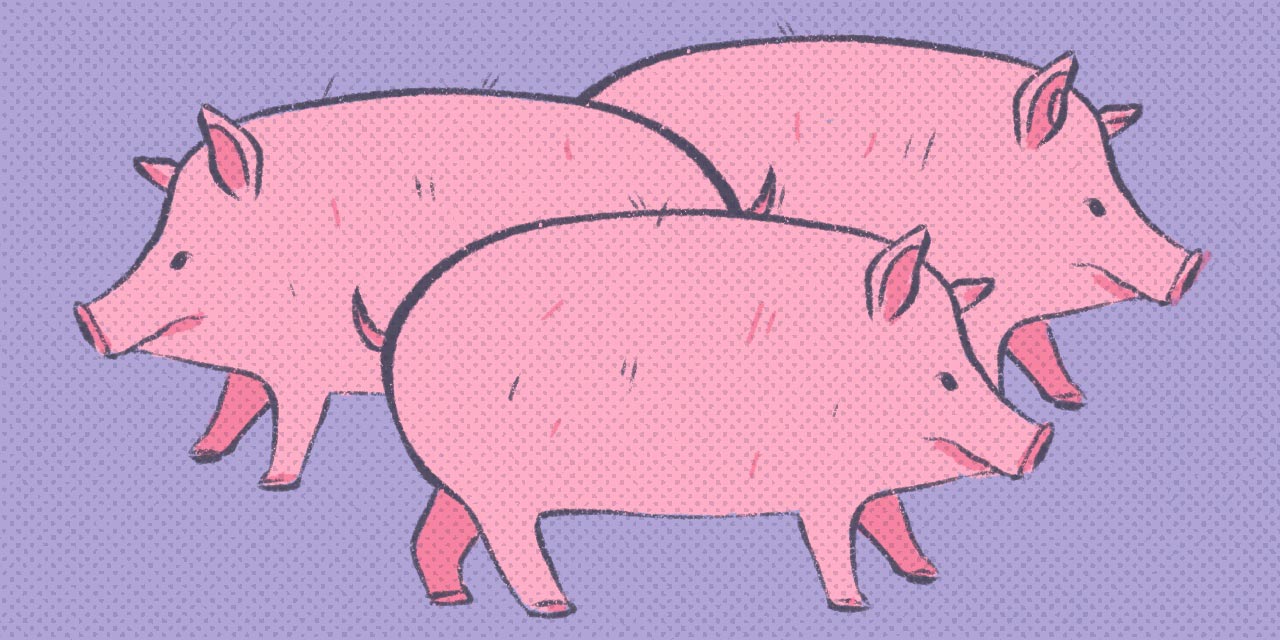if an adult person would have a difficult time picking up the animal, there's a good chance you can count it using 頭.
The Japanese counter 頭 (とう/tou) is usually described as "the counter for big animals." This includes horses, cows, elephants, and even big lizards. Its counterpart, the small-to-medium-sized animal counter 匹, overlaps with 頭 slightly; this article will help you to learn more precisely how it applies.
And yet… 頭 is the kanji for "head." Why then is 頭 used to count big animals? To answer that, we need only step back in time to the Meiji period, when Western ways were gaining influence in Japan. Westerners referred to cattle as "heads of cattle." From there, usage spread to other large (non-cattle) animals.
- Pronunciation of Japanese Counter 頭
- Large-Sized Animals (Mammals)
- Large Fish
- Large Reptiles & Amphibians
- Large Birds
- Professional Dogs
- Experimental Subjects
- Animals in Facilities
- Now You Tō-tally Know How to Count with 頭
Prerequisite: If you're completely new to Japanese counters, we recommend you learn the basics first. Make sure you know how to read hiragana and katakana. We'll mention the "kango/wago/gairaigo counting method," and you can learn about all three of these Japanese numbering systems in our Counting in Japanese article. Knowing the kanji for numbers will help, too. In our example sentences and explanations, we equally use Arabic numerals (1, 2, 3) and Japanese kanji (一, 二, 三), since both are quite common in Japanese.
Pronunciation of Japanese Counter 頭
Before heading into what 頭 counts, though, let's learn the correct pronunciation for this counter.
| Numeral | Japanese | Reading 1 | |
|---|---|---|---|
| 1 | 一頭 | いっとう | |
| 2 | 二頭 | にとう | |
| 3 | 三頭 | さんとう | |
| 4 | 四頭 | よんとう | |
| 5 | 五頭 | ごとう | |
| 6 | 六頭 | ろくとう | |
| 7 | 七頭 | ななとう (しちとう) | |
| 8 | 八頭 | はちとう/はっとう | |
| 9 | 九頭 | きゅうとう | |
| 10 | 十頭 | じゅっとう/じっとう | |
| 11 | 十一頭 | じゅういっとう | |
| 12 | 十二頭 | じゅうにとう | |
| 100 | 百頭 | ひゃくとう | |
| 1,000 | 千頭 | せんとう | |
| 10,000 | 一万頭 | いちまんとう | |
| how many | 何頭 | なんとう |
Because 頭 has a t- sound, the pronunciations of 1, 8, and 10 aren't completely straightforward. Be careful of this, and don't forget you can always study the general counting rules in our Japanese Counters Guide.
Large-Sized Animals (Mammals)

Here's the easiest way to determine if 頭 is used: if an adult person would have a difficult time picking up the animal, there's a good chance you can count it using 頭—this means horses, cows, bears, elephants, and even whales. What about dolphins? Dolphins aren't that big, and you could probably pick one up. Nevertheless, dolphins get grouped with whales and are therefore counted with 頭. 🐬 🐬 🐬
- この牧場には馬が八頭います。
- On this farm there are eight horses.
- 私の叔父の家は牛を二頭飼っています。
- My uncle keeps two cows at his house.
- この動物園には、北極熊が三頭いる。
- There are three polar bears in this zoo.
- クジラ1頭と、約30頭のイルカの群れを観察した。
- We observed one whale and a group of about thirty dolphins.
There are exceptions, of course. Certain smaller animals are also counted with 頭, but generally they're creatures that are raised for consumption, like pigs or sheep. Again, this harkens back to the history of animals referred to as "heads."
- 羊を一頭買いした。
- I bought a whole sheep.
- レチョンとは、豚を一頭炭火で丸焼きにするフィリピン料理です。
- Lechon is a Filipino dish where you roast a whole pig on charcoal.
As for other smaller animals, certain big, strong, or aggressive-looking dogs may also be counted with 頭. We'll talk more about this in the "professional dogs" category in a moment, but it's worth mentioning here.
- あそこの家の庭にはドーベルマンが四頭放し飼いにされている。
- That house has four Dobermans running free in their yard.
Large Fish

Regular fish are usually counted with 匹, although some people count big fish and sea creatures such as whale sharks or orcas using 頭.
- あそこにでっかいジンベエザメが一頭いたよ。
- There was a huge whale shark over there.
Regular fish are usually counted with 匹, although some people count big fish and sea creatures such as whale sharks or orcas using 頭.
As they might for other edible mammals, some people use 頭 to emphasize the size of a big, whole fish, such as a tuna, although in cases like these, the counter 本 will be used most often.
Consider this: when it's alive, a tuna is usually counted with 匹. When captured, it's counted with 尾, 本, or 頭. When the head is cut off, it's counted with ドレス (the "-less" of "headless"). As the fish gets cut into smaller and smaller pieces, its counter continues to change. But we'll refrain from those details for now, because what we're teaching you is 頭!
Are you understanding how complicated this is yet?
- 静かな海の底にマグロの兄弟が三匹暮らしていました。
- At the bottom of the tranquil ocean, there were three tuna brothers living together.
- 日曜日にマグロを一頭買いして解体ショーを開催します。
- We are going to hold a whole tuna filleting event this Sunday.
- この居酒屋はマグロを一本買いして提供しているので、値段が安い。
- This izakaya buys whole tuna and serves them, so the price is reasonable.
Large Reptiles & Amphibians

Large reptiles and amphibians can also be counted with 頭, including crocodiles, alligators, monitor lizards, dinosaurs, and so on.
- 恐竜二頭とトーフグが遊んでいる絵を描いた。
- I drew an illustration where two dinosaurs and Tofugu were playing together.
- バナナワニ園には、何頭の鰐がいますか?
- How many alligators are there in Banana Wani?
Although turtles and tortoises aren't necessarily very big, they can also be counted with 頭. Amphibians in general can be counted with either 匹 or 頭. If you feel like they're on the smaller side, go with 匹. If you feel like they're pretty big, go with 頭, even if you can technically pick them up. Don't stress out about it too much; counting these creatures often goes either way.
- ビエトは、オオトカゲを一匹ペットにしているらしい。
- I heard that Viet keeps one monitor lizard as his pet.
- あの池でワニガメを二匹目撃しました。
- I saw two alligator snapping turtles in that pond.
- 先週、この池で二頭のワニガメが捕獲されました。
- Two alligator snapping turtles were captured in this pond last week.
Large Birds

It's rare, but there are times when large birds get counted with 頭. Think of ostriches or emus.
- 7頭のダチョウが走っている写真を撮った。
- I took a photo of seven ostriches running.
As for the question on everybody's mind: would Sesame Street's Big Bird be counted with 頭? We would say no, as Big Bird is a friend of humans and can talk. That means he'd be counted with the person counter 人, despite basically being a (very friendly large yellow) monster, which can be counted with 匹.
Professional Dogs

Even if they are very small, professional, job-holding dogs trained by humans—police dogs, drug-sniffing dogs, guide dogs, or rescue dogs—are usually counted with 頭.
- 三頭のチワワが警察犬として頑張っています。
- Three Chihuahuas are working hard as police dogs.
- 空港で柴犬を一頭見かけたが、どうやら麻薬探知犬だったようだ。
- I saw one Shiba Inu at the airport, but it seems it was a drug-sniffing dog.
- 今年はこの学校の五頭のラブラドールレトリバーが盲導犬になりました。
- This year, five Labrador Retrievers from this school became guide dogs.
In theory, other "professional animals" would be counted with 頭, too—a drug-sniffing chimpanzee or mouse, for example.
Experimental Subjects

Animals that are being experimented upon have a "job" and are "professionals," in a way.
Even though you can probably easily pick most of them up, animals like lab rats who are the subjects of experimentation are counted with 頭, even if they're small. Think of this as an extension of "professional animals": even though they didn't sign up for it, animals that are being experimented upon have a "job" and are "professionals," in a way.
- この実験には20頭のラットが使用された。
- Twenty rats were used for this experiment.
Rare / Valuable Animals and Insects
Rare or valuable animals can be counted with 頭, too, regardless of size. Endangered animals like the golden hamster, or expensive insects like the stag beetle are counted this way.
- 絶滅の危機にある狼が4頭保護された。
- Four wolves in danger of extinction were caught for protection.
- 珍しい昆虫を3頭捕まえた。
- I caught three rare insects.
- このカブトムシはとても貴重で、1頭22万円で取引されています。
- This beetle is very valuable, so it's traded at ¥220,000 per beetle.
To emphasize how valuable and rare their stock is, pet shops in Japan tend to count everything with 頭. It makes things seem more fancy, even if you're only buying a common gerbil.
Insects (Academic)

For the most part, insects are counted with 匹. In an academic setting, however, they're done so using 頭. Think of it like insects on display in a museum, or being used in a classroom for study: these bugs are "professional job-holding" bugs, although their job is to be dead and to be studied. 🐞
- この昆虫博物館には、3000頭の昆虫が保管されている。
- 3,000 insects are stored in this insect museum.
- この掛軸には、4頭の蝶が描かれている。
- There are four butterflies painted on this hanging scroll.
- この部屋には、15頭のアンタエウスオオクワガタの標本が展示されています。
- In this room, fifteen specimens of Dorcus antaeus are on display.
This academic usage of 頭 actually expanded to normal-life use for a while. People once counted butterflies using 頭, though this particular use has become archaic. These days, we'd recommend using 匹 for living and non-academic butterflies.
Harmful Animals and Insects
When an insect or animal is harmful to humans, it can be counted with 頭, regardless of size. Here's an example: you count regular beetles using 匹; if you're a farmer, however, and a swarm of them arrives and eats all your corn, you'd count them with 頭. The 頭 here emphasizes the harm the animal is causing.
- バラの根を食べる黄金虫の幼虫を100頭捕獲した。
- We caught a hundred Japanese beetle grubs that eat rose roots.
- 畑を荒らす猪を四頭駆除した。
- We exterminated four wild boars that messed up our field.
Farm Animals

Although the category overlaps with several others, farm animals, and even farm insects like silkworms, are generally counted with 頭. This is especially true when they are listed in an official report. This is another example of "professional animals with jobs." Whether it's to be eaten, produce wool or silk, or provide milk, they have a job to do!
- マミは家の裏で2匹の豚を飼っています。
- Mami has two pigs in her backyard.
- カナダのとある養豚場で、2020頭のうち450頭が新型ウイルスに感染していたことが報じられた。
- It was reported that 450 of the 2,020 pigs in a Canadian piggery have been infected by a new type of virus.
- 政府は養豚業者に対し、豚1頭あたり100ドル補償することを発表した。
- The government announced that they will pay $100 per pig to the pig farmers as compensation.
- この牧場では、今年は48頭の母羊が出産する予定です。
- On this farm, forty-eight mother sheep are expected to give birth this year.
- 私の祖父の養蚕所には、昔は千頭以上の蚕がいたそうです。
- I heard that my grandpa's cocoonery used to have over a thousand silkworms.
That said, there will be times when these kinds of animals can be counted with 匹 as well.
- どうやら二匹の羊が群れからはぐれてしまったようだ。
- It seems two sheep strayed from the flock.
- 母豚の横には、5頭の子豚がスヤスヤと眠っていた。
- Five baby pigs were sleeping soundly beside the mother pig.
Animals in Facilities

Like farm animals, other animals kept in facilities tend to be counted with 頭. For example, the zookeepers of the Ueno Zoo count every kind of animal there with 頭, regardless of size. Iida Asako, the author of the book 日本の助数詞に親しむ, interviewed one of the zookeepers to ask him why. He didn't know why this was the case. The only animals he could think of that are counted with 匹 were the grasshoppers used to feed the iguanas.
- この山には野生のチンパンジーが少なくとも300匹は暮らしているそうだ。
- It seems at least 300 wild chimpanzees are living on this mountain.
- この動物園に新しくチンパンジーの雄1頭と雌4頭がやって来ます。
- One new male chimpanzee and four new female chimpanzees are coming to this zoo.
- このセンターでは、148頭のサルのうち約2割がアレルギーに悩まされています。
- In this center, about 20% of the 148 monkeys are suffering from allergies.
- 日本モンキーセンターには約800頭の猿が飼育展示されている。
- The Japan Monkey Center raises and displays about 800 monkeys.
Now You Tō-tally Know How to Count with 頭
How would you count Crabigator, our WaniKani mascot? Even we're not 100% sure!
That's all the categories for counting with 頭. A quick review: 頭 is used to count not only big animals but professional animals as well, although the definition of "professional" gets stretched sometimes. Some exceptions outside those two broad categories exist, including rare animals and insects and animals that cause humans harm.
In considering the gray areas between the Japanese counters 頭 and 匹, both can be valid, so don't worry about it too much. Just be sure to read about 匹 too, so you can make an educated guess.
For example, how would you count Crabigator, our WaniKani mascot? Even we're not 100% sure! We have to consider things like, "How big is it?" as well as, "Is it rare, valuable, or harmful to humans?" With those questions in mind, we would have to lean towards 頭. Crabigator is quite large, rare, valuable, and harmful to humans (at least those humans who don't want to learn kanji). By thinking through these kinds of questions, you'll be more likely to guess whether 頭 or 匹 is the right counter to use. Sometimes your answer will be: "Why not both?"
And with that, we bet you're pretty full of counter knowledge for now (you have to take time to let it all digest in your brain). But next time you're hungry for counters, we've got you covered: 台, 個, and 〜つ are some of the other "deep dives" we've written.
And if this was your first counters experience, we suggest you read about the basics of Japanese counters, and then head over to the big Japanese counters study list we put together, which also has links to every in-depth counters article we've written up to this point.
-
Cells with multiple entries divided by a
/indicate multiple pronunciations that are equally common. Cells with entries in parentheses indicate that the parenthesized word is an uncommon or archaic pronunciation. ↩
